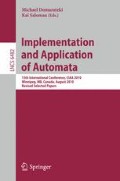Abstract
We investigate synchronous systems consisting of two finite automata running in opposite directions on a shared read-only input. The automata communicate by sending messages. The communication is quantitatively measured by the number of messages sent during a computation. It is shown that even the weakest non-trivial devices in question, that is, systems that are allowed to communicate constantly often only, accept non-context-free languages. We investigate the computational capacity of the devices in question and prove a strict four-level hierarchy depending on the number of messages sent. The strictness of the hierarchy is shown by means of Kolmogorov complexity. For systems with unlimited communication several properties are known to be undecidable. A question is to what extent communication has to be reduced in order to regain decidability. Here, we derive that the problems remain non-semidecidable even if the communication is reduced to a limit close to the logarithm of the length of the input. Furthermore, we show that the border between decidability and undecidability is crossed when the communication is reduced to be constant. In this case only semilinear languages can be accepted.
Access this chapter
Tax calculation will be finalised at checkout
Purchases are for personal use only
Preview
Unable to display preview. Download preview PDF.
References
Czeizler, E., Czeizler, E.: On the power of parallel communicating Watson-Crick automata systems. Theoret. Comput. Sci. 358, 142–147 (2006)
Czeizler, E., Czeizler, E., Kari, L., Salomaa, K.: On the descriptional complexity of Watson-Crick automata. Theoret. Comput. Sci. 410, 3250–3260 (2009)
Freund, R., Păun, G., Rozenberg, G., Salomaa, A.: Watson-Crick finite automata. In: DIMACS Workshop on DNA Based Computers, University of Pennsylvania, pp. 305–317 (1997)
Hartmanis, J.: Context-free languages and Turing machine computations. Proc. Symposia in Applied Mathematics 19, 42–51 (1967)
Ibarra, O.H.: Reversal-bounded multicounter machines and their decision problems. J. ACM 25, 116–133 (1978)
Jurdziński, T., Kutyłowski, M.: Communication gap for finite memory devices. In: Yu, Y., Spirakis, P.G., van Leeuwen, J. (eds.) ICALP 2001. LNCS, vol. 2076, pp. 1052–1064. Springer, Heidelberg (2001)
Jurdziński, T., Kutyłowski, M., Loryś, K.: Multi-party finite computations. In: Asano, T., Imai, H., Lee, D.T., Nakano, S.-i., Tokuyama, T. (eds.) COCOON 1999. LNCS, vol. 1627, pp. 318–329. Springer, Heidelberg (1999)
Leupold, P., Nagy, B.: 5′→3′ Watson-Crick automata with several runs. In: Non-Classical Models of Automata and Applications (NCMA 2009). books@ocg.at, vol. 256, pp. 167–180. Austrian Computer Society (2009)
Li, M., Vitányi, P.: An Introduction to Kolmogorov Complexity and Its Applications. Springer, Heidelberg (1993)
Martín-Vide, C., Mateescu, A., Mitrana, V.: Parallel finite automata systems communicating by states. Int. J. Found. Comput. Sci. 13, 733–749 (2002)
Mitrana, V.: On the degree of communication in parallel communicating finite automata systems. J. Autom. Lang. Comb. 5, 301–314 (2000)
Nagy, B.: On 5′→3′ sensing Watson-Crick finite automata. In: Garzon, M.H., Yan, H. (eds.) DNA 2007. LNCS, vol. 4848, pp. 256–262. Springer, Heidelberg (2008)
Păun, G., Rozenberg, G., Salomaa, A.: DNA Computing: New Computing Paradigms. Texts in Theoretical Computer Science. Springer, Heidelberg (1998)
Author information
Authors and Affiliations
Editor information
Editors and Affiliations
Rights and permissions
Copyright information
© 2011 Springer-Verlag Berlin Heidelberg
About this paper
Cite this paper
Kutrib, M., Malcher, A. (2011). Two-Party Watson-Crick Computations. In: Domaratzki, M., Salomaa, K. (eds) Implementation and Application of Automata. CIAA 2010. Lecture Notes in Computer Science, vol 6482. Springer, Berlin, Heidelberg. https://doi.org/10.1007/978-3-642-18098-9_21
Download citation
DOI: https://doi.org/10.1007/978-3-642-18098-9_21
Publisher Name: Springer, Berlin, Heidelberg
Print ISBN: 978-3-642-18097-2
Online ISBN: 978-3-642-18098-9
eBook Packages: Computer ScienceComputer Science (R0)

